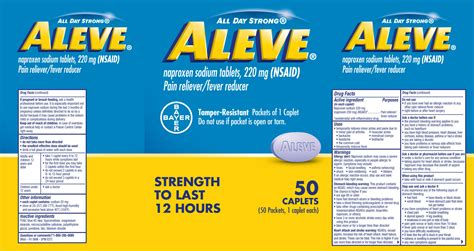Intro
Discover key facts about Naproxen Sodium, a potent NSAID, including its uses, side effects, and interactions, to safely manage pain, inflammation, and fever with this anti-inflammatory medication.
Naproxen sodium is a medication that has been widely used for its anti-inflammatory and pain-relieving properties. It is a key ingredient in several over-the-counter and prescription medications, including Aleve and Anaprox. Despite its popularity, many people are not aware of the full range of benefits and potential risks associated with naproxen sodium. In this article, we will delve into the world of naproxen sodium, exploring its uses, mechanisms, and side effects, as well as providing practical tips for safe and effective use.
The importance of understanding naproxen sodium cannot be overstated, as it is a medication that is often taken without a second thought. However, like all medications, it has the potential to interact with other substances and cause adverse reactions. By taking the time to learn about naproxen sodium, individuals can make informed decisions about their health and well-being. Whether you are a long-time user of naproxen sodium or are considering taking it for the first time, this article is designed to provide you with the information you need to navigate the complexities of this medication.
Naproxen sodium is a nonsteroidal anti-inflammatory drug (NSAID) that works by inhibiting the production of prostaglandins, which are hormone-like substances that cause pain and inflammation. It is commonly used to treat a range of conditions, including arthritis, menstrual cramps, and headaches. In addition to its pain-relieving properties, naproxen sodium also has anti-inflammatory effects, which can help to reduce swelling and redness in the affected area. With its wide range of uses and relatively low cost, it is no wonder that naproxen sodium has become a staple in many medicine cabinets.
What is Naproxen Sodium?

How Does Naproxen Sodium Work?
Naproxen sodium works by inhibiting the production of prostaglandins, which are produced by the enzyme cyclooxygenase (COX). There are two types of COX enzymes: COX-1 and COX-2. COX-1 is involved in the production of prostaglandins that protect the stomach lining and promote blood clotting, while COX-2 is involved in the production of prostaglandins that cause pain and inflammation. Naproxen sodium is a non-selective COX inhibitor, which means that it blocks both COX-1 and COX-2 enzymes. This can lead to a range of benefits, including reduced pain and inflammation, as well as some potential risks, such as stomach ulcers and bleeding.Benefits of Naproxen Sodium

Common Uses of Naproxen Sodium
Naproxen sodium is commonly used to treat a range of conditions, including: * Arthritis: Naproxen sodium can help to reduce pain and inflammation in the joints, making it an effective treatment for conditions such as osteoarthritis and rheumatoid arthritis. * Menstrual cramps: The medication can help to alleviate pain and inflammation associated with menstrual cramps, making it a popular choice for women who experience heavy or painful periods. * Headaches: Naproxen sodium can help to reduce pain and inflammation associated with headaches, including migraines and tension headaches. * Muscle and joint pain: The medication can help to alleviate pain and inflammation associated with muscle and joint pain, making it a popular choice for athletes and individuals who engage in strenuous physical activity.Risks and Side Effects of Naproxen Sodium

Precautions and Warnings
To minimize the risks associated with naproxen sodium, it is essential to take the medication as directed and to be aware of the potential side effects. Some precautions and warnings to be aware of include: * Take the medication with food: Taking naproxen sodium with food can help to reduce the risk of stomach ulcers and bleeding. * Avoid taking the medication for extended periods: Long-term use of naproxen sodium can increase the risk of side effects, including kidney damage and stomach ulcers. * Be aware of interactions with other medications: Naproxen sodium can interact with other medications, including blood thinners, diabetes medications, and blood pressure medications. * Monitor kidney function: Long-term use of naproxen sodium can increase the risk of kidney damage, particularly in individuals who have pre-existing kidney disease.Safe and Effective Use of Naproxen Sodium

Practical Tips for Taking Naproxen Sodium
Some practical tips for taking naproxen sodium include: * Take the medication with a full glass of water: This can help to reduce the risk of stomach ulcers and bleeding. * Avoid taking the medication on an empty stomach: Taking the medication on an empty stomach can increase the risk of stomach ulcers and bleeding. * Be aware of the potential for addiction: Naproxen sodium can be habit-forming, so it is essential to take the medication only as directed and to avoid taking it for extended periods.Conclusion and Final Thoughts

We hope that this article has provided you with a comprehensive understanding of naproxen sodium, including its uses, mechanisms, and potential risks. If you have any further questions or concerns, please do not hesitate to reach out to us. We invite you to share your thoughts and experiences with naproxen sodium in the comments section below, and to share this article with anyone who may benefit from the information.
What is naproxen sodium used for?
+Naproxen sodium is used to treat a range of conditions, including arthritis, menstrual cramps, and headaches.
How does naproxen sodium work?
+Naproxen sodium works by inhibiting the production of prostaglandins, which are hormone-like substances that cause pain and inflammation.
What are the potential side effects of naproxen sodium?
+The potential side effects of naproxen sodium include stomach ulcers and bleeding, allergic reactions, interactions with other medications, and kidney damage.
How can I minimize the risks associated with naproxen sodium?
+To minimize the risks associated with naproxen sodium, take the medication as directed, monitor your symptoms, be aware of potential interactions, and keep the medication out of reach of children.
Can I take naproxen sodium with other medications?
+Naproxen sodium can interact with other medications, including blood thinners, diabetes medications, and blood pressure medications. Be aware of these potential interactions and consult with your doctor or pharmacist before taking the medication.
